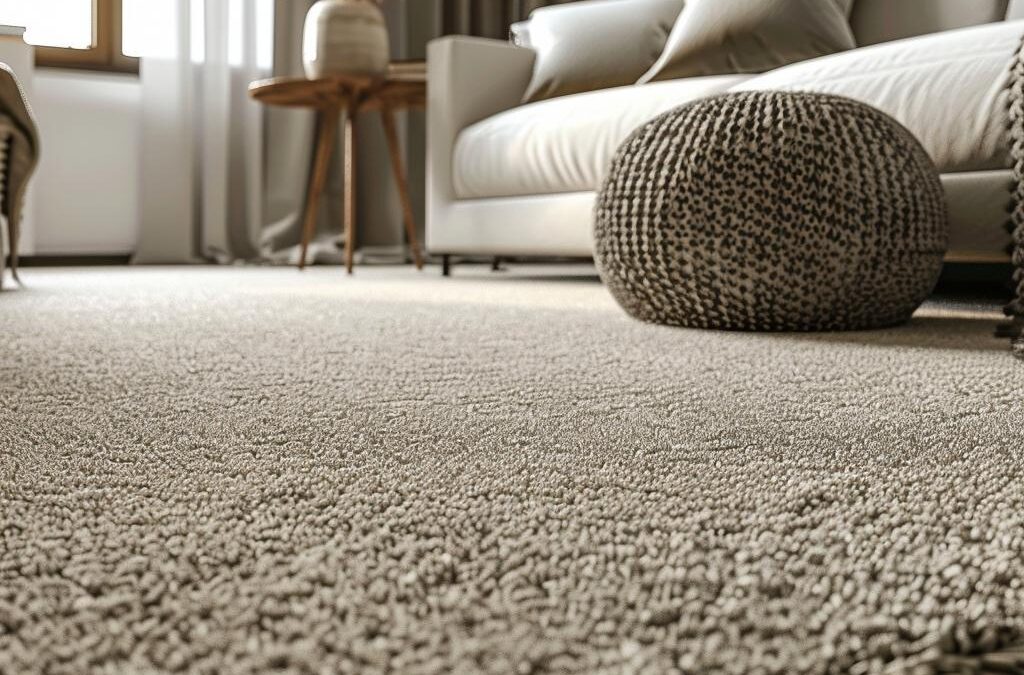Explore innovative waterless carpet cleaning techniques designed to lift away dirt, tackle stubborn stains, and safeguard your carpet’s delicate fibers—all without the risk of over-saturation. Dry carpet cleaning utilizes very low moisture (VLM) approaches, including dry compound, encapsulation, and bonnet cleaning, to effectively absorb grime and significantly speed up drying times. This comprehensive guide will walk you through:
- The essence of dry carpet cleaning and why it’s so effective
- Key methods, from dry compounds to specialized solvent treatments
- The advantages, potential drawbacks, and health implications
- Simple waterless solutions you can try at home
- When it’s time to call in the dry cleaning pros
- How dry cleaning stacks up against hot water extraction and steam cleaning
- The positive impact of eco-friendly compounds on your home’s air quality
At Elevate Cleaning ID, our deep expertise in area rug care informs every technique, ensuring your carpets are revitalized and fresh, free from moisture-related concerns.
What Exactly Is Dry Carpet Cleaning and How Does It Work?
Dry carpet cleaning relies on specialized powders, polymers, or solvents that expertly bind to dirt and lift stains using minimal moisture. This prevents your carpet fibers from becoming saturated, thereby eliminating the risk of mold growth. The process involves distributing a cleaning agent, gently working it into the carpet pile, and then vacuuming away the loosened soil and debris. This method is gentle on carpets while effectively restoring their appearance. Understanding the “very low moisture” (VLM) principle is key: carpets will be only slightly damp, if at all, and typically ready for foot traffic within an hour.
What Does “Dry” Really Mean in Dry Carpet Cleaning?
When we say “dry” in dry carpet cleaning, it refers to techniques that use less than 5% moisture content, not a complete absence of moisture. This minimal dampness is crucial for activating cleaning agents, such as enzymes, or for crystallizing soils, allowing them to be easily removed without over-wetting the carpet. For instance, encapsulation polymers work by trapping grease and soil into tiny micro-crystals that are then vacuumed away, leaving the fibers feeling fluffy and virtually dry to the touch.
This controlled moisture approach is vital for protecting the carpet’s backing, preventing shrinkage, and ensuring carpets are ready for use almost immediately. It sets the stage for selecting the perfect dry method tailored to your specific rug type.
Why Opt for Dry Carpet Cleaning for Your Carpets?
Dry cleaning actively enhances your carpet’s fiber integrity and contributes to healthier indoor air quality by avoiding the introduction of water-borne residues and the potential for mold growth. The rapid drying times mean less disruption in busy homes or commercial spaces, and the non-saturating compounds minimize the risk of damage to the carpet backing. For delicate natural fibers like wool or jute, a waterless process is essential to prevent color bleeding and warping.
Understanding these compelling benefits naturally leads to identifying which carpet constructions stand to gain the most from these advanced dry approaches.
Which Carpet Types Benefit Most from Dry Cleaning?
Carpets made from moisture-sensitive fibers—such as wool, jute, sisal, seagrass, and other delicate area rugs—thrive with VLM methods. Even synthetic carpets like nylon or polyester used in residential settings respond exceptionally well to dry powders and encapsulating detergents for regular upkeep and maintenance.
By choosing a cleaning method that perfectly matches your carpet’s fiber characteristics, you ensure effective soil removal without compromising its texture or appearance. This knowledge paves the way for exploring the specific dry cleaning techniques available.
Exploring the Main Dry Carpet Cleaning Techniques
There are five primary dry methods, each designed to address different types of soil, fiber compositions, and usage scenarios. Every process involves dispersing a specialized cleaning agent, agitating the carpet pile, and then efficiently removing residues using vacuums or absorbent tools, all while ensuring the carpet remains free from water saturation.
How Does Dry Compound Cleaning Effectively Tackle Dirt and Stains?
Dry compound cleaning involves applying specially formulated absorbent granules. These granules are infused with surfactants, solvents, and adsorbents that work together to penetrate carpet fibers, effectively bind to oils, and encapsulate soils. They are then thoroughly removed using a rotary brush machine or a powerful vacuum cleaner.
- Quick and easy application and removal process
- Perfect for carpets with light to moderate soiling
- Minimal downtime, ideal for busy commercial environments
This granular approach is exceptionally effective for routine maintenance cycles, keeping carpets looking refreshed and presentable between deeper cleaning sessions.
What Is Encapsulation Cleaning and How Does It Work Its Magic?
Encapsulation cleaning utilizes advanced polymer emulsions that work by encapsulating dirt particles into dry, crystalline residues. After an encapsulating solution is sprayed onto the carpet, a low-speed rotary machine evenly distributes it into the pile. As the polymer dries, it forms delicate crystals that trap soils, releasing them for easy vacuum removal. This process leaves the fibers cleaner and fluffier.
| Polymer Type | Mechanism of Action | Key Benefit |
|---|---|---|
| Acrylic emulsions | Forms crystals around surface grime | Efficient removal of everyday dirt |
| Cationic polymers | Binds electrostatically to particles | Captures microscopic allergens and fine dust |
| Zwitterionic gel | Utilizes dual-charge action | Expertly emulsifies greasy soils |
The precision of encapsulation makes it an excellent choice for maintaining the appearance of commercial office carpets and for frequent interim cleaning, ensuring a consistently neat look with minimal residue left behind.
How Does Bonnet Cleaning Effectively Clean Carpet Surfaces?
Bonnet cleaning involves using a highly absorbent pad, known as a bonnet, attached to a rotary buffer. This pad absorbs soil and cleaning solution directly from the carpet’s surface. The rotating motion of the pad agitates the tips of the carpet fibers, lifting away daily dirt and spills without penetrating deeply into the pile.
- Provides rapid turnaround for high-traffic areas
- Bonnet pads are replaced or laundered between cleaning passes
- Highly effective for surface rejuvenation and appearance maintenance
This method offers a quick surface-level clean, extending the time between more intensive dry or wet cleaning processes and helping to preserve the integrity of the carpet pile.
What Is Dry Foam Cleaning and When Is It the Best Choice?
Dry foam cleaning creates a low-moisture foam by expertly blending a concentrated detergent with air. This foam is then applied using a sprayer or a rotating brush machine, where it clings to carpet fibers and encapsulates soils as it dries. Once the foam has set, a powerful vacuum cleaner is used to lift away the dried foam crystals and the trapped debris.
- Ideal for spot cleaning and addressing moderate stains
- Provides controlled moisture distribution
- A gentle option for delicate fabric types
This method strikes an excellent balance between effective cleaning power and fiber safety, making it a suitable choice for both home and retail environments.
How Does Solvent Extraction Differ from Other Dry Methods?
Solvent extraction utilizes specialized organic solvents, such as d-limonene, which are highly effective at dissolving oils and waxes found in stubborn soils. A low-moisture rinse is typically applied afterward, followed by solvent recovery and vacuum extraction to remove contaminants and residues. This process is particularly effective for tough, greasy stains.
| Solvent Type | Typical Low Moisture Level | Specialized Use Case |
|---|---|---|
| d-Limonene | Less than 2% | Excellent for removing pet-related oil stains |
| Hydrocarbon blend | 3–4% | Highly effective for industrial grease elimination |
| Citrus-based mix | 1–2% | Specializes in odor neutralization |
Solvent extraction is the preferred method when dealing with water-sensitive fibers or heavy grease contamination that requires targeted degreasing without risking saturation of the carpet backing.
Unpacking the Benefits and Limitations of Dry Carpet Cleaning
Dry methods offer the significant advantage of rapid drying and enhanced fiber safety, but they also come with certain limitations. Understanding both aspects is crucial for selecting the most appropriate approach for your specific space and carpet type.
How Does Dry Cleaning Effectively Prevent Water Damage and Mold Growth?
By maintaining moisture levels below 5%, dry cleaning methods completely avoid carpet saturation and the risk of a wet carpet backing—primary culprits behind mold, mildew, and structural damage. The immediate vacuum removal of cleaning agents leaves carpet fibers nearly dry, effectively mitigating the proliferation of mold spores and protecting underlying subfloor materials.
Understanding Moisture Content and Mold Growth in Carpets
Extensive research highlights a direct and significant correlation between the moisture content within carpets and the subsequent growth of mold and mildew. It is critically important to maintain moisture levels below 5% to prevent microbial development and preserve the structural integrity of both the carpet fibers and their backing. Dry cleaning techniques inherently minimize moisture exposure, making them a safer choice.
This meticulously controlled moisture process not only supports healthier indoor environments but also ensures faster turnaround times for busy households and businesses alike.
What Are the Health and Environmental Advantages of Dry Cleaning?
Dry cleaning compounds frequently incorporate non-toxic surfactants and biodegradable polymers, which significantly reduce volatile organic compounds (VOCs) and allergens in your home. By effectively trapping dust mites, pollen, and pet dander within encapsulated residues, these dry approaches actively improve indoor air quality without resorting to harsh chemicals or excessive water usage.
The Impact of Dry Cleaning on Indoor Air Quality
Scientific studies indicate that dry cleaning methods, particularly those employing encapsulation technology, can substantially decrease the presence of allergens and volatile organic compounds (VOCs) within carpets, leading to a marked improvement in indoor air quality. This is achieved by effectively trapping common allergens like dust mites, pollen, and pet dander within the encapsulating polymers, preventing their circulation back into the air.
These environmentally conscious formulations align perfectly with sustainable cleaning practices and contribute to creating safer, healthier living spaces, especially for individuals with sensitivities.
What Are the Common Limitations of Dry Carpet Cleaning?
While dry methods excel at addressing surface soils and light to moderate stains, they may encounter challenges with deeply embedded dirt, heavy soiling, or stubborn, set-in stains. If residual powder or polymers are not completely removed, they can potentially attract new soils over time. Therefore, periodic deep wet cleaning, such as hot water extraction, remains essential for comprehensive deep-pile maintenance and restoration.
Effectively balancing routine maintenance cycles with occasional deep cleaning is the key to ensuring your carpets enjoy maximum longevity and maintain their optimal appearance.
How to Perform Dry Carpet Cleaning at Home Using Waterless Methods
DIY dry cleaning offers a convenient way to refresh your carpets between professional services, utilizing common household items and readily available over-the-counter powders. For tackling minor stains and odors, these methods can deliver quick, satisfying results.
How to Use Dry Carpet Cleaning Powder for Effective Spot Cleaning?
Begin by sprinkling a light layer of dry cleaning powder directly over the stain. Gently work the powder into the carpet fibers using a soft brush. Allow it to sit for about 10–15 minutes, giving the compounds ample time to adsorb oils and lift the stain. Finally, vacuum the area thoroughly until no powder residue remains visible.
- Protect the surrounding floor with a drop cloth.
- Apply the powder and gently agitate the carpet pile.
- Vacuum the treated area, starting from the edges and moving inward.
- Repeat the process if necessary for particularly stubborn spots.
Successful spot treatment is crucial for keeping your carpets looking fresh and ready for their next deep cleaning cycle.
Can Baking Soda and Vinegar Be Used for Dry Carpet Cleaning?
Baking soda is a fantastic natural deodorizer and moisture absorber, while a fine mist of white vinegar can help loosen light soils. To use them, lightly mist a stain with white vinegar, then sprinkle baking soda over the damp area. Allow it to fizz and work for about 5 minutes. Once dry, vacuum up the resulting crystals to remove odors and loosened particles.
These natural compounds introduce minimal moisture and leave behind a fresh scent, offering an effective and eco-friendly interim cleaning solution.
When Is DIY Dry Cleaning Appropriate, and When Should You Call Professionals?
DIY methods are perfectly suited for handling minor spills, addressing pet odors, and performing routine refreshes. However, carpets subjected to heavy foot traffic, those with deep-set stains, or particularly delicate fibers—such as oriental, antique, or natural fiber rugs—absolutely require professional care to prevent irreversible damage.
Understanding these distinctions is key to maintaining your carpets effectively while preserving their long-term beauty and integrity.
When to Entrust Your Carpets to Professional Dry Cleaning Services
Professional dry cleaning combines cutting-edge equipment, powerful industry-grade compounds, and specialized technical expertise to effectively tackle challenging soils and meticulously preserve delicate carpet fibers.
Why Are Professionals the Best Choice for Delicate Area Rugs?
Specialized rug fibers, including silk, wool, and jute, demand precise moisture control and exceptionally gentle agitation. Certified professionals possess the expertise to assess each rug’s fiber type, dye stability, and pile construction before selecting the most appropriate dry method. This ensures prevention of shrinkage, color bleeding, or distortion.
This highly tailored approach safeguards valuable area rugs and guarantees optimal restoration without introducing any risk of damage.
What Advanced Equipment and Techniques Do Professionals Employ?
Certified technicians utilize sophisticated equipment such as rotary agitation machines, specialized encapsulation applicators, bonnet buffers, and advanced solvent extraction systems, all precisely calibrated for low-moisture operation. They employ proprietary compounds that are far more effective at crystallizing and adsorbing soils than standard consumer products. Furthermore, HEPA-filtered vacuums are used to extract even microscopic residues.
By skillfully integrating multiple dry methods, professionals achieve a deeper level of clean with minimal disruption and downtime.
How to Identify Reliable Professional Area Rug Dry Cleaning Services?
When searching for a service, look for certified providers who clearly specialize in area rug cleaning. Pay close attention to strong local reviews, and ensure they offer transparent descriptions of their cleaning processes. It’s also wise to verify their use of eco-friendly compounds and inquire about drying times, service warranties, and guarantees for fiber safety.
Engaging true specialists ensures your carpets receive the absolute highest standard of care, preserving their beauty for years to come.
Comparing Dry Carpet Cleaning to Hot Water Extraction and Steam Cleaning
A clear comparison between dry and wet cleaning methods helps clarify which approach is best suited for your specific maintenance needs.
| Method | Moisture Level | Drying Time | Cleaning Depth | Ideal Use Case |
|---|---|---|---|---|
| Dry Compound/Encapsulation | Less than 5% | Under 1 hour | Surface & light soil removal | Frequent interim maintenance |
| Hot Water Extraction | 60–70% | 6–12 hours | Deep-pile extraction | Thorough deep cleaning, heavy soiling |
| Steam Cleaning | 40–50% | 4–8 hours | Surface and sub-pile cleaning | Sanitizing and allergen removal |
What Are the Key Differences Between Dry and Wet Carpet Cleaning?
Dry methods employ minimal moisture, leaving no wet backing, which significantly reduces the risk of mold and minimizes downtime. Wet methods, while penetrating deeper to tackle heavy soils, require extended drying periods and carry the risk of over-wetting carpet fibers if not managed correctly.
This fundamental contrast is key for scheduling: dry cleaning is ideal for regular upkeep, while wet extraction is best reserved for periodic deep restoration needs.
When Is Dry Cleaning a More Effective Choice Than Hot Water Extraction?
Dry cleaning truly shines when rapid turnaround is a critical factor—think retail environments, busy offices, or homes where same-day use is essential. It is also the preferred method for delicate fibers and moisture-sensitive carpet backings, as VLM systems are inherently gentler.
Recognizing these specific scenarios ensures you protect your carpet’s health and avoid potential water-related damage.
What Are the Pros and Cons of Each Method for Carpet Maintenance?
Dry cleaning offers the significant advantage of quick reuse and enhanced fiber safety, but it primarily addresses surface soils. Wet extraction provides a more comprehensive deep clean but involves longer downtime and carries the potential risk of mold if carpets are not dried thoroughly and promptly.
Integrating both methods into a well-planned maintenance schedule is the ultimate strategy for balanced, high-performance carpet care.
What Are the Environmental and Health Advantages of Dry Carpet Cleaning?
Dry methods actively support sustainable practices, conserve precious water resources, and reduce chemical exposure, aligning perfectly with green building initiatives and health-conscious objectives.
How Do Non-Toxic and Biodegradable Compounds Enhance Indoor Air Quality?
Biodegradable surfactants and advanced encapsulating polymers naturally break down into harmless components, significantly minimizing VOC emissions. By effectively capturing allergens within dry residues, they prevent the recirculation of dust mites and pollen, leading to noticeably cleaner breathing air without the presence of harsh chemical odors.
This environmentally responsible approach cultivates healthier living and working environments for everyone.
Why Is Dry Cleaning Preferred for Allergy and Chemical Sensitivity Concerns?
The minimal moisture used in dry cleaning, combined with plant-based cleaning agents, drastically reduces exposure to potential mold spores and common irritants. Without harsh detergents or lingering dampness, individuals with sensitivities are less likely to experience allergic reactions or respiratory issues following a cleaning session.
Consequently, dry methods offer a demonstrably safer alternative for occupants who are chemically sensitive.
How Does Dry Cleaning Champion Sustainable Carpet Care Practices?
By reducing water consumption by as much as 90% compared to traditional hot water extraction, dry processes conserve vital resources and minimize wastewater discharge. The use of biodegradable compounds ensures environmental compatibility, while the reduced energy required for drying further lowers the overall carbon footprint.
Adopting VLM systems is a significant step towards greener facilities and demonstrates a commitment to long-term ecological stewardship.
Dry carpet cleaning methods provide swift, safe, and environmentally friendly solutions for maintaining your carpets’ performance and appearance. Whether you opt for a convenient DIY powder for quick spot treatments or choose to partner with professional area rug specialists, understanding these techniques is your key to ensuring your flooring remains fresh, healthy, and beautiful for years to come. For the expert care of delicate or high-value rugs, always trust a specialized cleaning service to meticulously preserve fiber integrity and deliver superior, lasting results.






